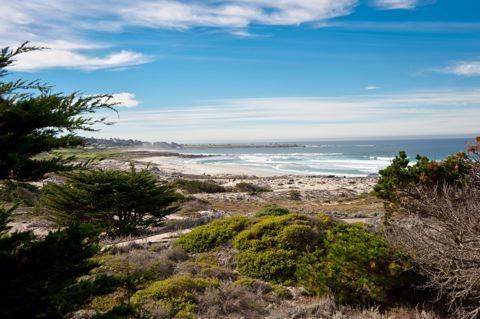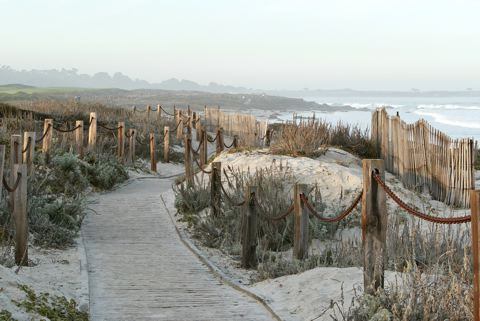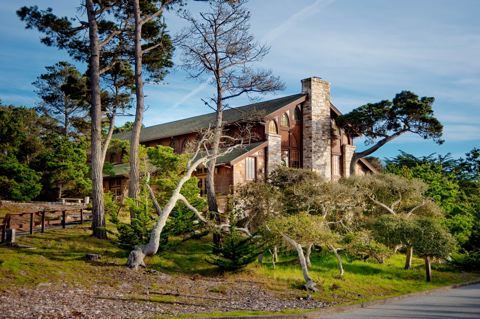 As autumn rolls in, there are certain go-to destinations on most travelers’ agendas. But as savvy travelers know, there is a bounty of fall activities in some unexpected states. Grateful Traveler Jamie Simons explores seasonal events, state parks and other tucked-away gems of California’s Central Coast.
As autumn rolls in, there are certain go-to destinations on most travelers’ agendas. But as savvy travelers know, there is a bounty of fall activities in some unexpected states. Grateful Traveler Jamie Simons explores seasonal events, state parks and other tucked-away gems of California’s Central Coast.
True confession… So-called travel writers are never supposed to say, “My favorite is this.” Or “I love that.” But at the moment, I feel compelled to break that rule. And here’s why…
I live in California and now is the time of year when locals bemoan our lack of autumn grandeur. I grew up in the East, along the Vermont border, and I know firsthand what everyone’s talking about. But in California, we can easily go mano to mano with the best the rest of the country (if not the world) has to offer.
For proof, just head to California’s Central Coast in October. Unlike the fog-drenched days of summer, the sun comes out and actually decides to stay. And while everything that attracts hordes of travelers in July and August—the Monterey Bay Aquarium, Carmel’s art galleries, shops and cafes, the magnificent serpentine coastline—are still as enjoyable as ever, the crowds are gone. That’s when savvy locals come out to play.
Why? This is the time of year when thousands of monarch butterflies take up residence in the coast’s eucalyptus trees, 5000-pound bull elephant seals can be found lolling on the beaches and pods of grey whales swim by on their way to the calving grounds of Mexico.
The celebration starts the first week of October with the Butterfly Parade and Bazaar in the Monterey Peninsula town of Pacific Grove. Held on the first Saturday of October for the past 71 years, the parade features school children dressed as butterflies, otters, American Indians, pioneers, and, just for good measure, clowns.
After the parade, head over to the Mariposa Butterfly Sanctuary just off Lighthouse Road to witness the return of the monarchs to their winter home. Then on Sunday, sign up to sneak a peek behind the usually closed doors of Pacific Grove’s famous Victorian homes as they open to the public for docent-led tours.
If your kids are along and home tours aren’t their thing, do what we always do and make it a point to visit the state natural preserve at Point Lobos. The trails are easy and offer a front-row seat for spotting whales, dolphins, cormorants, pelicans, sea lions and seals. There are tide pools for exploring and whole “rooms” of bent and twisted cypress trees that, when the sun hits them exactly right, light up as if fairies lived within.
As with any tourist destination, the Carmel and Monterey area is filled with lodging choices that range in price from inexpensive to ultra-luxurious. But for our money, the area holds only one place that brings us back again and again and that’s Asilomar State Beach and Conference Grounds, a California state park.
Designed in 1913 as a YWCA camp by Julia Morgan of Hearst Castle fame, Asilomar sits on 107 acres of beachfront property. And while its famous, and expensive, neighbors sport names like Spanish Bay and Pebble Beach, Asilomar’s state park prices remain the same year round—between $80 and $180 per night (depending on weekday or weekend) for a family of four, with a gourmet breakfast thrown in.
At present, the rooms are functional, not fancy, although all are slated to be redone soon. But that’s not the point of the place. For a family like ours, with an only child, I know I can sit in the dining hall, sip coffee and have conversations with total strangers (everything is served family-style and you sit at any available table) and watch my daughter walk up to the main lodge by herself. There she always finds kids to play with and whether shooting pool or doing puzzles, suddenly our lone little traveler isn’t so lonely any more.

Because Asilomar caters mainly to large conference groups, only about 15 percent of the rooms are available for travelers who are on their own. But sporting a beach with flour-soft sand, magnificent and historically significant architecture, a view of the links at Pebble Beach and one of the most reasonable locally grown and sustainable menus around, it’s worth reserving your spot up to six months in advance.
While it’s possible to eat at Asilomar three times a day, there are so many great eateries in the area it would be a shame to miss out on their offerings. Our personal favorite in Pacific Grove is the tiny Red House Café; others swear by the more pricey and gourmet Passionfish.
Heading south from Carmel on Highway 1, (not for white-knuckle passengers), the go-to places are Big Sur, San Simeon, Cambria, Morro Bay, Pismo Beach and the college town of San Luis Obispo. All of these are well-worth a stop.
But at this time of year, try something different. Make your way down the coast via the state parks and beaches that the butterflies and elephant seals flock to. It says something about the Central Coast that the state of California has deemed 18 different sites worth preserving on just 130 miles of road.
Find out why by combining a stop at San Simeon State Park and Hearst Castle with a visit to the elephant seal rookery at Piedras Blancas, a mere 7.7 miles north of the famous castle. Or take in the redwoods at Pfeiffer Big Sur State Park but make sure to leave time for a stop at the Monarch Butterfly Natural Preserve at Pismo Beach.
As for accommodations, I’m partial to Big Sur Lodge inside Pfeiffer Big Sur State Park. Rooms start at $189 and include free passes to five of the area’s best state parks.
But the Central Coast is rich, not only with B&Bs, hotels and motels but also with great camping spots. Some, like Kirk and Plaskett Creek, are run by the Forest Service and boast perfect jumping off spots for hiking the wildflower-filled, redwood forests of the Ventana Wilderness. Others, like Julia Pfeiffer Burns and Montana de Oro are state parks that will have you studying the night sky from a moonlit beach.
 If camping is not your travel style, all the coastal towns offer plenty of places to both stay and to eat. Our usual destination is not the more popular Morro Bay or Cambria, but the kid and dog-friendly little town of Cayucos. A beach town that’s just a few blocks long, it still boasts one of the best-known gourmet eateries on the coast—Hoppe’s Bistro & Wine Bar—as well as little tucked-in-the-wall places like Skipper’s (don’t be surprised to see movie stars eating at what everyone in town affectionately calls a dive) and our personal favorite: the Old Cayucos Bakery & Deli.
If camping is not your travel style, all the coastal towns offer plenty of places to both stay and to eat. Our usual destination is not the more popular Morro Bay or Cambria, but the kid and dog-friendly little town of Cayucos. A beach town that’s just a few blocks long, it still boasts one of the best-known gourmet eateries on the coast—Hoppe’s Bistro & Wine Bar—as well as little tucked-in-the-wall places like Skipper’s (don’t be surprised to see movie stars eating at what everyone in town affectionately calls a dive) and our personal favorite: the Old Cayucos Bakery & Deli.
As for rooms, if you have a dog, bring it. Cayucos caters to dog-lovers and almost every place in town allows them in your room, for a fee.
When we come to town, sans dog, we make it a point to stay at the Seaside Motel. Owned by a husband and wife team for the past 29 years, Rick and Rebecca Roquet go out of their way to make everyone feel completely at home right down to the individually decorated rooms and Rebecca’s gorgeous garden.
My particular reason for holding this quirky little place close to my heart? Rebecca was the first person to clue me into the fact that, like the maple trees of Vermont and New Hampshire, the Central Coast is at the height of its beauty in autumn.
Related articles on PeterGreenberg.com:
- 10 Affordable Fall Getaways in the USA & Abroad
- California Travel section
- Wine-Tasting & Shopping in Mendocino, California
- Ask the Locals Travel Guide: Santa Barbara, California
By Jamie Simons for PeterGreenberg.com. Photos by Wayne Capili, Interface Visual, as indicated. Jamie Simons is a freelance writer who has spent the last year living in California’s Yosemite National Park.












